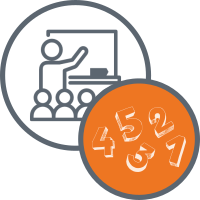You are here
Effective Mathematics Teaching Practice 1: Establish Mathematics Goals to Focus Learning
Instructional Support Menu
Establish Mathematics Goals to Focus Learning
NCTM's first effective teaching practice is to establish goals to focus learning. The most poignant aspect of this teaching practice is that mathematics teachers must be more focused on meaningful shifts in student understanding rather than just what students are expected to be doing. This is the difference between a learning goal and a performance goal. Compare the following goal statements:
Goal A: Students will recognize that the area of the square built on the hypotenuse of a right triangle is equal to the sum of the areas of the squares built on the legs and will conjecture that c2=a2+b2.
Goal B: Students will be able to (SWBAT) use the Pythagorean Theorem (c2=a2+b2) to solve a series of missing value problems.
Goal A is a learning goal, as it describes the reasoning and understanding we want students to learn as the result of instruction. Goal B is a performance goal, as it falls short of describing what learning is being done and instead essentially says, “Students will solve problems using a theorem.” While part of the lesson activity may include solving a series of problems, our goals should focus on the learning to be developed, not the tasks to be performed. Doing so sets up everything for the rest of the lesson: the tasks that are chosen, the representations students use, questions to be asked, the focus of classroom discussion, and assessment strategies.
Effective teaching of mathematics establishes clear goals for the mathematics that students are learning, situates goals within learning progressions, and uses the goals to guide instructional decisions.
-NCTM (2014), p. 12
The Practice in Action
One of the ways NCTM (2014, p. 16) summarizes the practice of establish mathematics goals to focus learning is by describing a set of actions expected of teachers and students that indicate engagement in this teaching practice.
Caution! Don't over-estimate your own understanding based on these brief descriptions of teaching practice. Professional educators should dig more deeply into NCTM's resources, join study groups and professional networks, and seek out professional development and coaching to ensure high-quality engagement in the practice.
What are teachers doing?
- Establishing clear goals that articulate the mathematics that students are learning as a result of instruction in a lesson, over a series of lessons, or throughout a unit.
- Identifying how the goals fit within a mathematics learning progression.
- Discussing and referring to the mathematical purpose and goal of a lesson during instruction to ensure that students understand how the current work contributes to their learning.
- Using the mathematics goals to guide lesson planning and reflection and to make in-the-moment decisions during instruction.
What are students doing?
- Engaging in discussions of the mathematical purpose and goals related to their current work in the mathematics classroom (e.g., What are we learning? Why are we learning it?)
- Using the learning goals to stay focused on their progress in improving their understanding of mathematics content and proficiency in using mathematical practices.
- Connecting their current work with the mathematics that they studied previously and seeing where the mathematics is going.
- Assessing and monitoring their own understanding and progress toward the mathematics learning goals.
Resources
- Principles to Action: Ensuring Mathematical Success for All (NCTM, 2014, pp. 12-16)
- Taking Action: Implementing Effective Mathematics Teaching Practices in K-Grade 5 (NCTM, 2017, pp. 17-35)
- Taking Action: Implementing Effective Mathematics Teaching Practices in Grades 6-8 (NCTM, 2017, pp. 15-27)
- Taking Action: Implementing Effective Mathematics Teaching Practices in Grades 9-12 (NCTM, 2017, pp. 15-27)
- Enhancing Classroom Practice with Research behind Principles to Actions (NCTM, 2017, pp. 1-11)
- Catalyzing Change in Middle School Mathematics (NCTM, 2020, pp. 59)




Connect With Us





